Menu
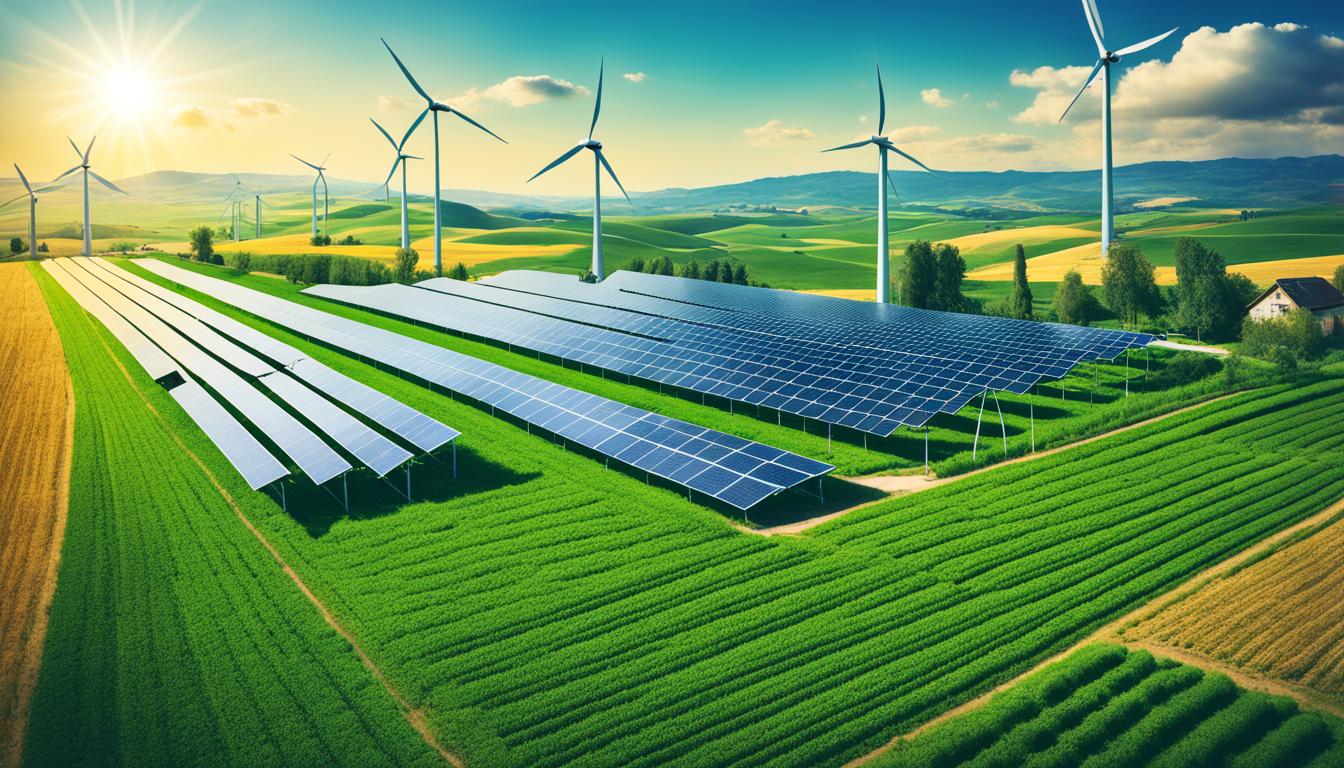
Agriculture is in the midst of its fourth revolution, thanks to ICT. This change is huge. It involves sensor technologies that check on things like how cattle move, the weather close to crops, and the acidity of the soil. There are also systems that handle water, chemicals, and power use. The National Academy of Sciences believes these steps are leading us towards a more sustainable way of farming.
At the University of Illinois, scholars are deep into talking about how digital and AI can make agriculture sustainable. Even though some farmers are not quick to adopt these new technologies, big research projects are finding out if they’d be into it. The goal is to show farmers the long-term benefits of going digital. They’re looking at how these tools impact the environment too.
Today, farming is changing fast. Digital tools are key for keeping our farms sustainable. A report by the National Academy of Sciences in 2017 told us that “Agriculture is changing because there is more and more technology used.” This includes farm management software, agtech innovations, and smart farming applications. These are vital for a green future in agriculture.
We now use sensors to watch things like the sky, how cows move, and small changes in weather. This gives farmers up-to-the-minute info to make smarter choices. For example, with remote systems, they can use water, chemicals, and power better for growing plants. This way, they waste less of these resources.
Also, agtech offers drones with high-tech eyes to check on big farms. Such checks give close-ups of how well crops are doing. And, new biotech including CRISPR is making plant breeding faster and more accurate. This leads to plants that grow better, avoid illness, and give more food.
Advanced tracking and GPS are changing how we look after the machines used in farming. They give exact details on how gear is used and when it needs fixing. This helps make choices that boost how much food the land can produce. Also, using smart farming apps means farming gets more productive, costs less, and produces more food. This shows the big gains from digital farming.
Now, our world is dealing with big problems. Using AI in farming could be a big help to make it green. The success of these new techs depends on farmers seeing good results. So, we need to keep highlighting the good digital tools do. This will get more farmers to try them out.
Putting digital tools into farming can make it more effective and help the environment. In 2023, just 27 percent of U.S. farms used digital farming methods. This means more farmers should learn about the upsides of these technologies to use them.

Digital farming helps make every step more efficient. It uses tools like georeferencing to make sure work in the field happens smoothly. This saves time and resources when putting things into the soil or gathering crops. With better data collection and smart apps, everything can be done just right.
Digital tools can boost farm output in a way that’s kind to the planet. By closely watching crops and soil with AI, farmers can give plants exactly what they need. This doesn’t just improve the harvest but also saves money by not wasting resources. Smarter ways to water the fields and AI advice help farmers spend where it matters most, raising their output.
Using digital in farming has big wins for nature. It helps deal with issues like not enough water and too much nitrogen harming the soil. Tools for watering that’s spot on reduce water use and protect this precious resource. Plus, less chemical use means the soil stays healthy and farms can last longer.
The list below shows some of the biggest pluses of digital farming:
| Benefit | Description | Example |
|---|---|---|
| Increased Efficiency | Optimises field operations and enhances data use | Georeferencing and location technologies |
| Improved Yield | Enhances crop productivity through precise inputs | AI-driven crop monitoring |
| Lower Costs | Reduces resource waste and operational expenses | Smart irrigation systems |
| Environmental Benefits | Promotes sustainable use of water and chemicals | Site-specific irrigation and precision management |
From 2017 to 2021, the USDA and NSF invested nearly $200 million in making farming more precise. This shows how key these technologies are. More support for studying and improving them can help farmers overcome hurdles and fully enjoy the benefits of digital farming.
Bringing digital tools into farming faces tough challenges. Big hurdles include money matters and how farmers usually act. These factors slow down the use of new farming technology.
One big roadblock is the cost of getting into digital farming. New gear like precise watering systems and small robots costs a lot upfront. Even though they can make farms more productive and eco-friendly, many farmers can’t see the immediate benefits. The U.S. Department of Agriculture points out that not many farms – only 20% – are using digital tools widely yet. The big costs and the tricky tech make this decision even harder.
How farmers feel and what they learn from others also affects their tech choices. Being wary of risks and what their peers do hold back on trying new tech. Many think one tech upgrade alone can’t solve all their problems. A mix of surveys and computer models helps forecast if new tech will be welcome on farms.
Showing the real perks of farm tech is key to breaking these problems. Offering rewards for using tech and talking about how it benefits both the wallet and the environment helps. Talking to farmers in a way that says, “This tech can help fix your problems,” is more effective. Tech that’s easy to use, can grow with the farm, keeps data safe, and is private shows real worth to farmers.
To wrap up, getting past economic and behaviour issues needs everyone in farming to talk more about how tech helps. This talk should be about how tech overcomes farming problems and not just about selling devices.
As agricultural technology gets better, precision agriculture is becoming more important. It helps make farming more sustainable and productive. Through precision agriculture, farmers can manage their fields more closely. It matches what they do to exact conditions. This way, they use less and get more, reducing waste.
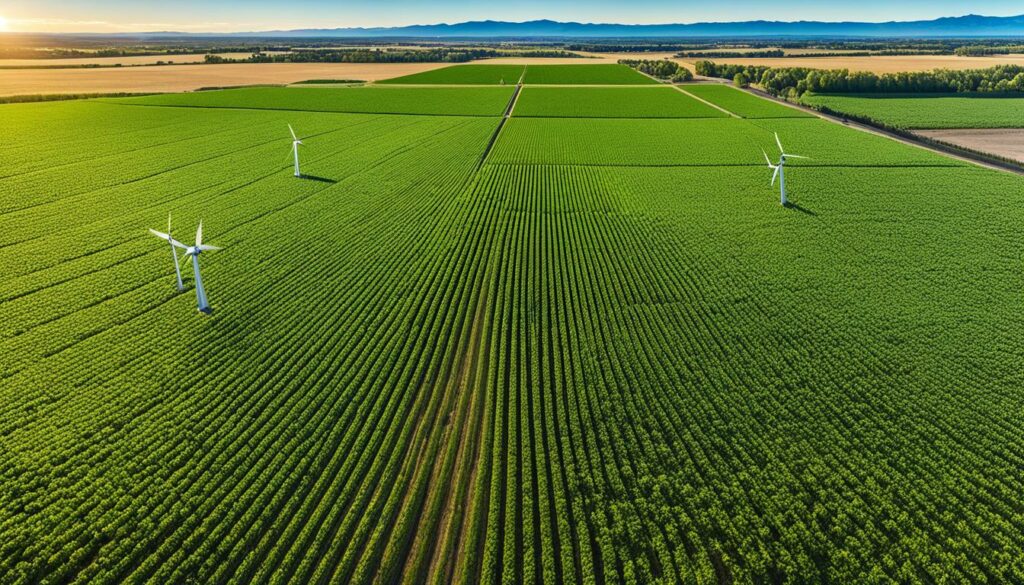
With site-specific management, farmers split their fields into zones. They can then give just the needed amounts of things like fertilisers and water. Variable Rate Technology (VRT) figures out the right fertiliser amount using soil and yield data. This cuts fertiliser use by 7%. Managing herbicides this way reduces use by 9%. This means less harm to the environment and saves money.
Irrigation is key in precision agriculture. It has led to a 4% cut in water use. These systems water crops just enough at the right time. This saves water and improves crop health. These systems also use RTK corrections for accurate seed and fertiliser placement.
Precision farming helps reduce fossil fuel use by 6%. It lets farmers handle big areas from afar. Drones with RTK make field checks quick and easy. With RTK becoming more affordable and accessible, farmers worldwide can benefit.
In conclusion, precision agriculture is changing the game. With the use of smart irrigation and close field management, it’s saving our soil and making farming sustainable for the future.
Artificial Intelligence (AI) is changing modern farming by offering future insights and making precise changes. As the world’s population heads towards 10 billion by 2050, there is a big squeeze on farmers. They’re called to up their game in crop production and yield. Here, AI’s smart ways are key to meet these goals in a green and efficient way.
The use of AI in farming is set to leap from USD 1.7 billion in 2023 to USD 4.7 billion by 2028. This massive growth hints at its significant role. AI tools help farmers quickly gather and analyse data. They offer vital info on what the market needs, price trends, and the best times to plant and harvest. This speed in sorting through data is very important for running farms better and making wise choices.
AI is also driving big changes in precision farming. It allows farmers to grow more with less, using fewer resources. This means less weed killer, better crops, more money, and saving cash. Importantly, the use of AI here means looking after the planet better. It helps in using water and fertiliser with a lighter touch.
In addition, automation is taking over tasks in farming. Things like self-driven tractors, drones for the farm, and smart watering systems do the job better than humans. These AI tools keep an eye on crops, find sick animals, apply bug spray just right, and map out how well a crop is doing. They all offer on-the-spot advice and future insights.
Scientist Ranveer Chandra says digital methods can make farming better and fairer. Microsoft has started a project called FarmBeats for school students. It lets kids from K to 12 try their hand at digital farming. This kind of learning will likely lead to new breakthroughs in farming tech.
Using AI in farming also means looking to the future. It helps farmers know the best times to plant, boost soil, and reap. It even gives heads-up on bad weather, crop sickness, and possible lost crops. This foresight allows farmers to make the best choices. These choices help farming be more eco-friendly and ready for any challenges that come.
Digital farming tools are helping to save our planet. They make farming better and protect nature. The University of Illinois found that farmers who use these tools care more about the environment. These findings were published in Agricultural Economics.
One important digital tool is AI. It helps farmers plant smarter, use less water, and grow food more efficiently. Farmers are starting to like these tools because they help the earth and boost their crops.
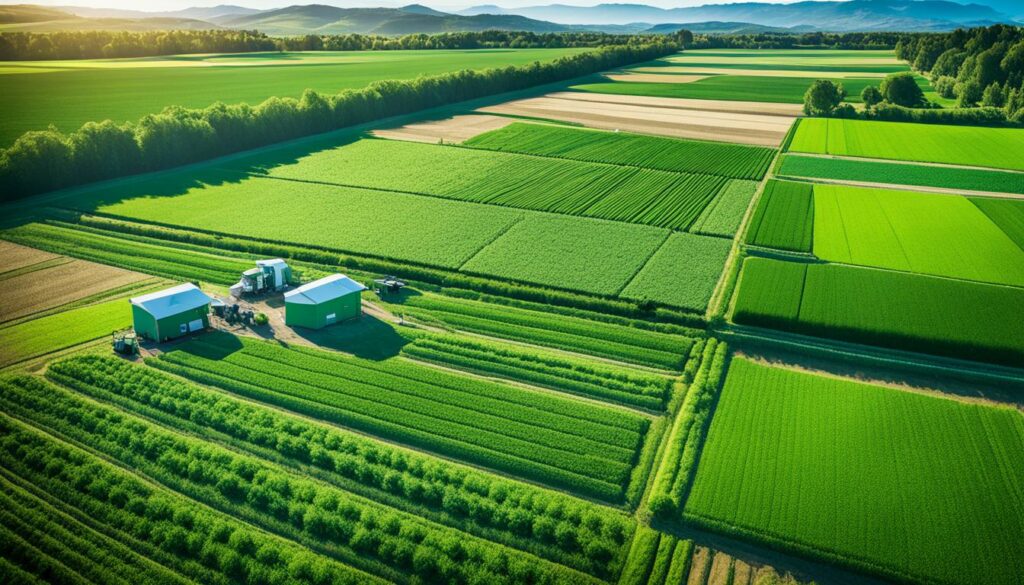
AI is not just for planting; it also helps check on crops and soil. It tells farmers exactly what their fields need, reducing waste and pollution. Robots underneath plants are another cool tool. They help farmers plant cover crops and use less harmful chemicals.
Using these tools can cost a lot at first, and farmers have to learn how to use them. Sometimes, they don’t see enough benefits to make the investment worthwhile. But, understanding how these tools work and the good they can do is also important. Farmers want to know for sure that these tools help before they start using them.
To help farmers decide, researchers use surveys and computer models. Farmers are asked to pick what they would do in different situations. This gives valuable information about what they need and worry about.
In 2017, the National Academy of Sciences said farming was entering a new phase. This change is powered by technology. We now have sensors that watch over fields and animals. They tell farmers how crops are doing and if they’re healthy.
Wireless systems are also key for farming smart. They help manage water, chemicals, and electricity better. Drones are flying over fields, too. They take pictures, help check over crops, and spray against pests. All this shows how modern tech is changing farming for the better.
Biotechnology is also growing fast. Techniques like CRISPR make plants and animals healthier. For years, farmers have been using special animals that grow faster, are stronger, and resist diseases.
Finally, GPS and other tracking systems are important for managing farm tools. They tell farmers how to use machines better and save on fuel. All these digital solutions are together helping farming use fewer resources and be kinder to the earth.
Farm management software, including ERP systems, has changed farming. It brings big improvements in how farms run and helps the environment.
ERP systems for farms put all farm data in one place. This makes everything run smoother and helps manage resources better. Farmers can use facts to do better at growing their crops. This can boost productivity and follow the rules better. ERP systems reduce the need for manual work by up to 25% because they do tasks for the farmer.
Good farm software helps farmers make smart choices. Using these systems cuts costs by 20% because it makes farms use what they have better. It uses facts to guess how much crop you will get and it plans when to plant. It then uses just enough water and fertilizer. This gets rid of waste and makes farms kinder to the planet.
Many farmers are picking up this efficient software at a fast rate, 15% more each year. They like that it saves about 10 hours a week in paperwork. This lets them spend more time farming. Big farms find this software especially helpful. It makes them 30% more efficient than smaller farms.
| Metric | Improvement/Impact |
|---|---|
| Farm Productivity Increase | Up to 25% |
| Cost Reduction | 20% |
| Water Usage Reduction | 30% |
| Chemical Pesticide Decrease | 20% |
| Time Savings | 10 hours per week |
| Compliance Rate | 95% |
Farm management software is key for doing farming well and eco-friendly. It helps the farm business make more money. And it’s better for the planet too, all thanks to smart tech and numbers.
Addressing environmental hurdles in farming requires smart tools. These tools give clear steps and facts. They help farmers lower their impact on the Earth.
Carbon accounting in farming offers a detailed way to tackle greenhouse gas emissions. It helps find where emissions are high and suggests ways to cut them. These tools make meeting eco rules simpler and they help in carbon trading.
Agricultural GHG reporting tools are key for tracking emissions. They allow a systematic way to document what’s being put into the air. With clear and checkable data, farms can show they are working hard to be green. This leads to better choices for a greener future.

Using both these tools helps cut the big impact farming has on our planet. Farming is a major source of greenhouse gases and uses a lot of water. So, these tools are more important now than ever before.
The use of IoT in agriculture is growing fast. It’s changing how we farm, thanks to smart sensors. These tools help farmers know more about their farms in real time. This, in turn, helps them make better decisions. Farmers can now check their fields more accurately without even going there.
This move to new technology fits into the fourth agricultural era. It brings in big data, AI, and cloud computing. Why? Because the number of people working in farming is expected to drop. From 45.1% in 2011 to a predicted 25.7% by 2050 in India. So, using real-time farm data monitoring is key. It helps farms stay productive with fewer workers.
Benefits and Impact:
In poorer countries, using IoT in farming can make things better in many ways. It can make food more available, help farms deal with changes in the weather, and cut down on air pollution. Since farming is such a big part of these countries’ economies, using IoT tools is very important. It helps them meet goals for the future without hurting the planet.
Statistical Insights:
| Year | Agricultural Workforce Percentage | GDP Contribution |
|---|---|---|
| 1951 | 71.9% | — |
| 2011 | 45.1% | 18% (India) |
| 2050 | 25.7% (Projected) | — |
By using smart agricultural sensors, farmers can save money and protect the environment. This way of farming improves how farms are run. It also helps the whole farming system to be ready for the future. It’s very important to keep investing in IoT. This will keep helping farms grow in a way that is good for everyone.
The role of weather data in farming is crucial. Due to changing climates, farmers must use accurate weather information to make decisions. In 2022, the agriculture market grew rapidly, reaching $13 billion at the start of 2023. This shows how advanced technologies are key to managing farming better.
Weather greatly affects how well crops grow. Factors like temperature, rain, and wind are vital for crop health. Farmers use this data to improve their farming methods, which is good for the environment and their businesses.
Technology is changing farming for the better. By 2026, the market for IoT weather stations is expected to increase substantially. This shift towards more precise farming is seen all over. It includes using GPS, soil sensors, and drones to use resources better. For example, the right use of fertilisers can reduce costs and make crops healthier.
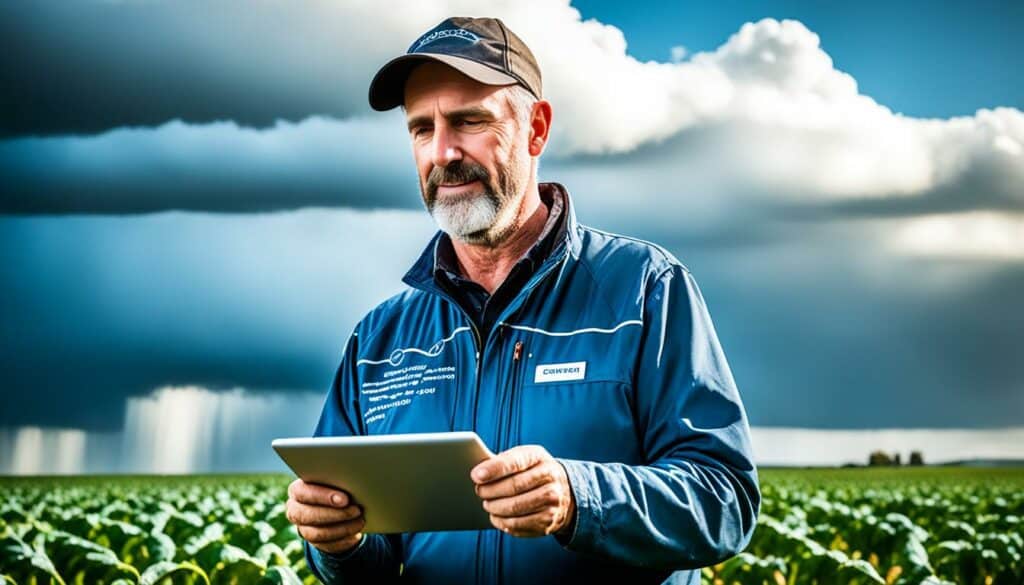
These new technologies help farms use resources well and increase their productivity. This is very important as food prices went up by 8.75% in 2022. So, it’s vital for farming to be efficient and effective, especially during times of high inflation.
I use AI and ML to look at weather data collected by IoT devices and predict the weather better. This helps farmers plan in smart ways. Also, using satellites to track crops and air quality gives farmers more useful information for decision-making.
| Parameters | Impact on Agriculture |
|---|---|
| Temperature | Affects crop growth stages and productivity |
| Precipitation | Influences soil moisture and irrigation needs |
| Sunlight | Determines photosynthesis and plant development |
| Wind | Impacts pollination and pest spread |
| Pest/Disease Forecasts | Guides pest control measures and reduces crop loss |
Using weather data helps farmers manage their resources smarter. It’s all about using IoT and analytics to make farming more sustainable. This approach is crucial for a strong and green agricultural future.
Remote sensing and satellite tech are key in sustainable farming. They provide farmers with detailed insights. These help manage resources better and grow crops more efficiently.
Remote sensing has changed how we check on crops. High-res images find crop problems early. Things like moisture stress and disease are spotted fast. This allows quick actions to fix them. ESRI found that 73% of farmers use this tech, showing how popular it is.
Healthy soil is vital for farming that lasts. Satellite tech checks soil health and moisture. This info helps with watering crops just right. Using GIS and remote sensing can save lots of water and cut down on fertilisers. Bayer and Google Cloud’s project is a clear example of this saving approach.
Knowing about pests and diseases early is key. Tech keeps a constant eye on crop health. So, issues are caught before they spread. Corteva’s system uses satellite data to manage weeds well. This success story shows the power of these tools in farming.
In short, remote sensing and satellite tech are crucial for modern farming. They improve how we watch crops and manage land. Plus, they help farm in ways that care for our planet. This all leads to farming that’s kinder to the environment.
| Technology | Use Case | Impact |
|---|---|---|
| Remote Sensing | Crop Monitoring | Identifies moisture stress, diseases, and nutrient levels |
| Satellite Technology | Soil Health Assessment | Optimises irrigation and fertiliser usage |
| GIS and Remote Sensing | Pest and Disease Prediction | Early detection and management of pests and diseases |
The world of farming is changing fast thanks to new tech, dubbed the fourth revolution. Leading this change are smart spray tech and drones. They’re making farming more sustainable and precise than ever.
Smart sprayers help farmers use chemicals more precisely. They cut down on the need for pesticides and herbicides. These sprayers use real-time data to treat only necessary spots, helping the environment and saving time and money. They are key in battling water scarcity, avoiding waste, and striving for better crop yields.
Drones are a big step forward in farming. They come with sensors and top-notch cameras that give important info on crops. From simple photos to detailed images, drones help monitor crop health and spot weeds early. This info leads to smarter choices on water, fertiliser, and pest control.
In 2017, the National Academy of Sciences recognised that farming was entering a big new phase. Thanks to technology like sensors and drones, we can watch over farms with precision. This tech lets us keep an eye on everything from the air, track cows, check the weather, to the soil quality.
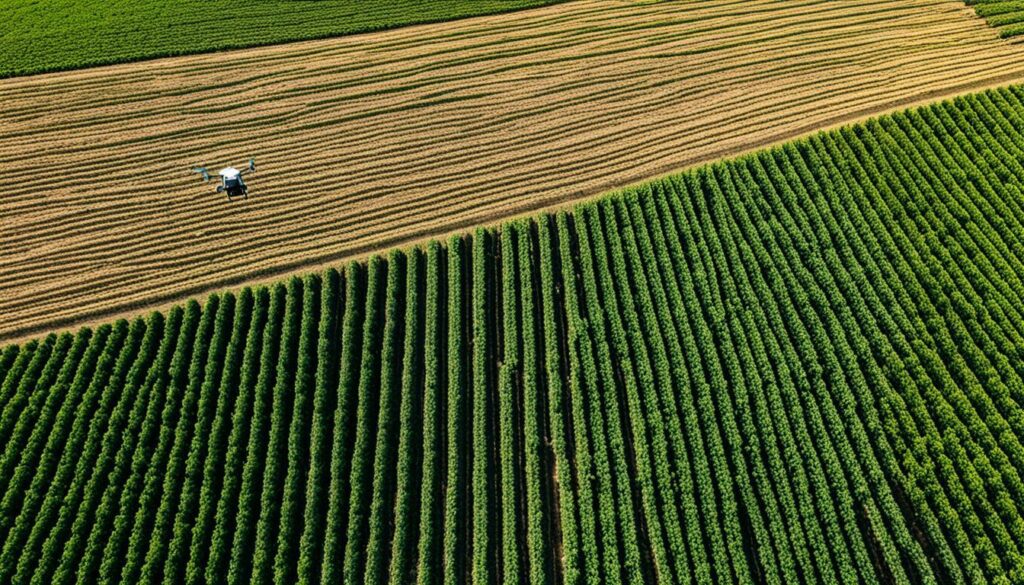
| Region | Agtech Adoption Rate | Top Agtech Innovation |
|---|---|---|
| North America | 61% | Drones in agriculture |
| South America | 50% | Precision spraying |
| Asia | 9% | Farm management software |
| Europe | 61% | Sensors and IoT |
Keeping up farm productivity against market ups and downs is crucial. With tech like smart sprayers and drones, farmers can use resources smarter. This tech, together with smart systems, makes farming more resilient and productive. It’s a key way for agriculture to move forward sustainably.
The agriculture sector is aiming to produce 70% more food by 2050 to feed over 10 billion people. However, there is a major challenge: not enough workers. To tackle this, digital solutions offer new ways through automation and improving how the agricultural workforce works. Modern tech helps farms work better, using less water and more resources wisely, and produce more.
One solution is using robots under crops to put down fertiliser and plant seeds. These robots work much faster than humans, about ten times. This helps fill the gap left by fewer farm workers. Also, it makes the work of those who are there more efficient.
Here are some stats to show how digital tools are changing farming:
| Statistic | Impact |
|---|---|
| Robotic Harvesters | Ten times faster than manual labour, aiding in increased efficiency |
| Indoor Vertical Farms | Utilise 70-95% less water and 90% less land than traditional methods |
| Crop Management Solutions | Reduce water consumption by 15-30%, saving on costs and upping yield |
| Livestock Management Technologies | Cut veterinary bills and insurance costs by keeping cattle healthier |
| Drones for Spraying | In South Korea, drones handle 30% of spraying, saving money and being more accurate |
Automation and tech are vital to solve the issue of less farm workers. Things like AI and precision agriculture tools make farms work with less manual work. This boosts both how much food is made and helps the environment. Also, tech that tracks supplies makes delivery more efficient, saves fuel, and keeps workers safer.
The agriculture industry must keep investing in these digital solutions. With the world’s population growing, using farm automation and tech to make farm work more efficient is key. It helps keep food available and supports farming for years to come.
Digital tools are changing farming worldwide. Take sub-Saharan Africa as an example. Here, there are over 400 digital tools being used. They cover financial services, connections to markets, managing supply chains, advice, and business insights. These tools show us both the benefits of using technology in farming and the challenges.
In this region, most digital tools are used by less than 30% of the users. However, about 5% of these tools have been very successful. They have helped over one million farmers. This shows that making tools that many can use is important for farming to improve.
One big challenge is poor infrastructure in Africa. Half of the area doesn’t have electricity. And buying even a basic mobile phone can cost more than most farmers earn in a month. This makes it hard for farmers to use digital tools. But, efforts to help can make a big difference.
India also has successful stories in digital farming. Between 2013 and 2020, the number of start-ups in farming technology grew a lot. For example, a partnership in Telegana using AI has boosted agriculture exports by 9%. This project also aims to make agriculture more sustainable and secure food supplies.
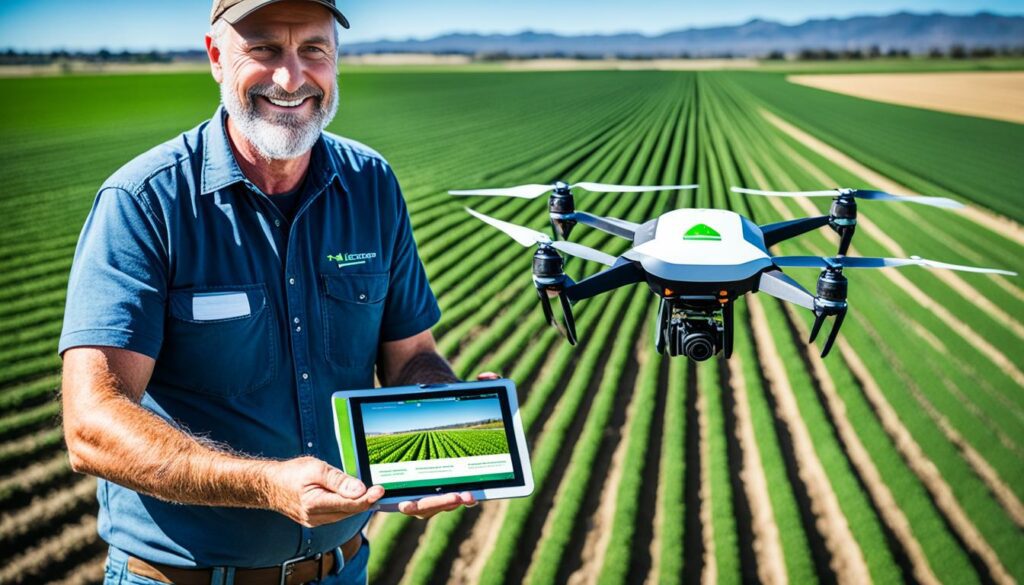
Other interesting successes come from using machines smartly. John Deere’s self-driving machines have increased farm output by 15%. And WiseConn’s system has cut water use in farming by 30%. These examples show how digital tools can make farming greener and more efficient.
Digital farming tools are being welcomed globally. They fit well into local markets because they are tailor-made. For instance, using digital models to predict crop outcomes leads to better harvests and sustainability. Technologies like AI, blockchain, and IoT are proving very useful in modern agriculture.
Here’s a closer look at some key digital interventions:
| Region | Technology | Impact |
|---|---|---|
| Sub-Saharan Africa | AI & Market Linkage Platforms | Improved reach to one million farmers; Enhanced policy-making |
| India | AI for Agriculture Innovation | 9% Increase in Agri Exports; Sustainable practices promotion |
| Global | John Deere Autonomous Machinery | 15% Productivity boost |
| Global | WiseConn’s DropControl | 30% Reduction in Water Usage |
Looking at these digital farming successes, it’s clear that focused efforts can lead to wide and positive digital use in farming. The evidence not only shows how successful use of technology happens but it also provides examples that can inspire more progress in the agriculture field.
The way we farm is changing fast because of new tech and more food needed. Digital farming’s future looks exciting. It will offer new ways to solve old problems in farming.
By 2050, the world will need 70% more food. New technology in farming, like indoor growing, will help. Indoor farms use less water and land. This is key to feeding more people sustainably.
Precision farming is also on the rise. By 2028, it could be worth $16.35 billion. It uses technology like AI to farm smarter. This helps farmers use resources better while predicting crop yields.
New tech in raising animals will also change how we farm. This includes tools to stop disease and scarecrows that work with lasers. These scarecrows cut crop damage by up to 90%.
In the next 10 years, farm software will grow fast, making things easier for farmers. It’s expected to benefit with the use of software like FarmERP. These help organise farms better. They also support managing water, which is vital for farming.
Drones will play a bigger role in agriculture, offering quick data and monitoring crops. They will help make farming more precise and efficient. This is part of a bigger trend towards data-driven farming.
Hydroponics and crops that resist drought are becoming more common. These efforts are part of a push for sustainable farming. This is key in fighting against climate change and the strain on our resources. Less human work is needed due to more machines, which can make farming more accurate and sustainable.
Farming is going digital all around the world, even in poorer countries. There are over 1,400 digital farming solutions, with huge potential profits. Companies like SourceTrace are doing big things in this area. They’re making farming smarter and more profitable.
In the end, the future of farming is about using new tech and being kind to the planet. With the right technology and farming practices, we can tackle big issues. These include feeding more people, managing resources well, and protecting our planet.
Digital tools are key for the future of sustainable farming. By 2050, we will need to feed over 10 billion people. Agriculture must boost production by 70% from 2009 levels. This big challenge calls for new technologies and better methods quickly.
Water management is a crucial area where digital tools help a lot. Today, farming uses 70% of the world’s fresh water, and much of it is wasted. But, tools for managing crops can cut water use by 15-30%. This not only saves money but also increases harvests. Indoor vertical farms use much less water and land, which is a big step forward.
In South Korea, 30% of agriculture spraying is done by drones. This shows farming is becoming more tech-savvy. Harvesting by robots is also 10 times quicker than by hand. These advancements help save food that would otherwise spoil during storage. They also make delivering produce more efficient, saving fuel and money.
Yet, farming faces issues like using too many resources and harming the environment. But, by using precision agriculture and smart tech, we can move towards more sustainable farming. As technology grows, it will continue to be a big part of agriculture. It helps us aim for a future where farming is both sustainable and productive.
Digital tools in farming boost efficiency and cut costs. They also help the environment. These tools make farming more precise and eco-friendly.
Digital tech saves resources, improves crop health, and cuts waste. It does this through smart irrigation and AI insights. These tools make farming greener.
The big costs up front and slow results are big barriers. Farmers may not see the value immediately, so they hold back.
AI offers smart predictions and advice in farming. It helps with planting, fertilising, and pest control. This makes farming greener and more efficient.
IoT sensors give real-time data on things like soil moisture and animal actions. They allow for quick, precise farming adjustments. This improves farm management and supports the planet.
Precision agriculture focuses farming on tiny field details. It uses precise irrigation and management. This cuts waste and boosts crops sustainably.
Farm software keeps track of all farm details in one place. It helps see usage, decide smarter, and use resources better. This improves farming and lowers harm to the environment.
These tools help farmers spot and reduce pollution. They simplify reports and promote green actions. Farmers can also gain from reducing emissions this way.
These tools provide valuable crop and soil info from above. They predict pests and help manage farm resources better. They boost farming’s green efforts.
Digital farm tech, like robots, does important farm tasks. It lessens the need for workers. This changes how farms work and makes them more sustainable.